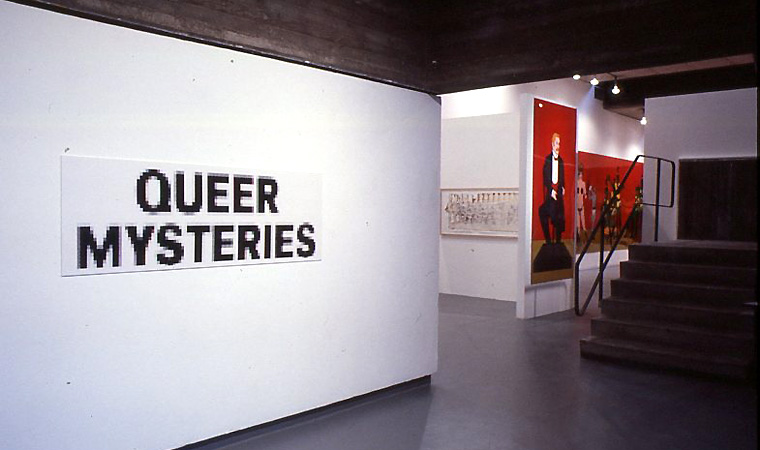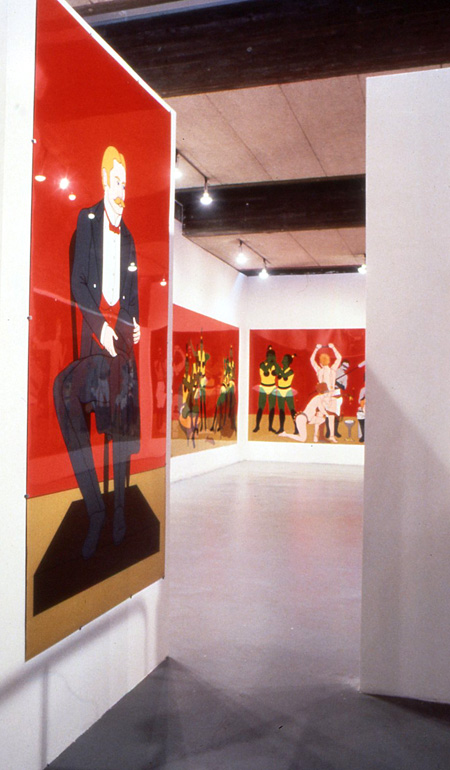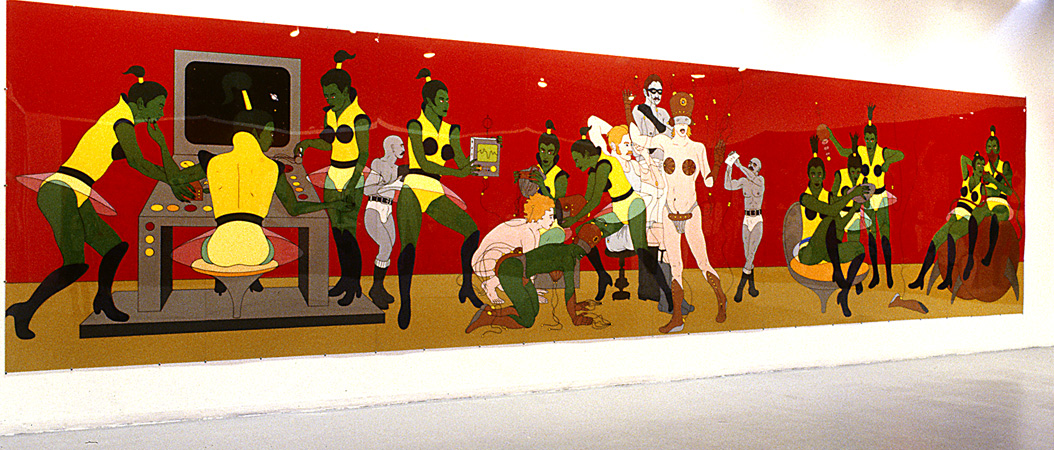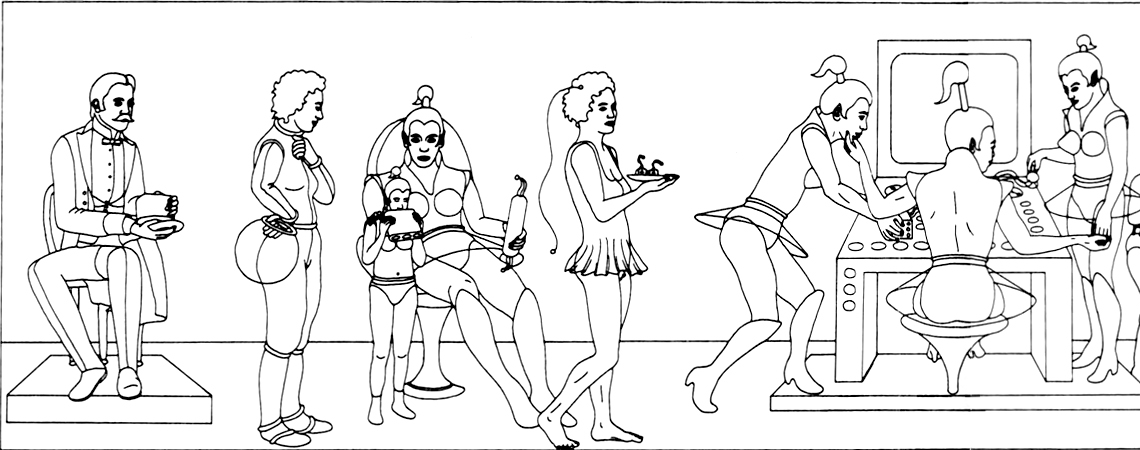Queer Mysteries
(1993)
In the collection of the San Francisco Museum of Modern Art.
Acrylic back painted on plexiglass, 8’X192’
Acrylic back painted on plexiglass, 8’X192’
Wall Text from the Adeline Kent Award Exhibition at the San Francisco Art Institute
Queer Mysteries is a mural in the round, loosely based on the original Fresco Villa of the Mysteries in Pompeii.
The original shows in frieze narrative the rights of passage of a neophyte entering the cult of Dionysus. In Queer Mysteries there are two overlapping narratives, a lesbian sci-fi version that reads left to right and a gay Edwardian horror version that reads right to left.
Characters have changed in gender and activity from the original, but each version has the same number of figures posed similarly to the originals in Pompeii. Both versions overlap, and include the gaps of the room in the Villa where the doorway and windows exist. This new version is larger than the original because our 20th Century life-size contrasts with the smaller average height in the early Roman Empire.
The location of the corners in Queer Mysteries differs from the original as well, to conform to the available space and shape of differing exhibition spaces. The single panel that forms a doorway is both the first panel of the installation and the final panel of the Edwardian story. In an ideal configuration, this panel and its sci-fi equivalent (the Earthling woman in alien garb) would form a double doorway. This would show the two final figures as an introduction, and the mural would surround the viewer who closes the doors.
What is the meaning of these Queer Mysteries?
The Dionysian original is incomplete, with portions missing. There is disagreement among art historians, anthropologists and other professionals as to both the meanings of the whole and the importance of particular symbols and actions. The Jungian interpretation allowed the artist to use a single character as protagonist, making for a more effortless reading of the narratives as they overlap.
This setup also allowed David free play with particulars of the original narrative, to add new meanings and mysteries, and to deal with both personal obsessions and comment on our world at the Second Millennium.
Like the original, these are representations of initiation rituals that occur universally, from puberty rites and fraternity hazings to weddings and religious conversions. They are all ceremonies of belonging.
While the original documents a ceremony for the entrance of women into a religious cult in a society that repressed and controlled social and political outlets for women, Queer Mysteries comically poses specific rituals for coming out as a member of the gay community (as if it was possible), while simultaneously poking fun at the 20th Century corruption of the psychic value of myth and ritual into such vicarious forms as comics and B grade film in our secular culture. Lesbians are cold but sexy aliens, and gay men cavort as sex crazed cannibals, mad scientists and blasé gentry, a commentary on the nightmare fantasies of homophobes everywhere.
Queer Mysteries is a mural in the round, loosely based on the original Fresco Villa of the Mysteries in Pompeii.
The original shows in frieze narrative the rights of passage of a neophyte entering the cult of Dionysus. In Queer Mysteries there are two overlapping narratives, a lesbian sci-fi version that reads left to right and a gay Edwardian horror version that reads right to left.
Characters have changed in gender and activity from the original, but each version has the same number of figures posed similarly to the originals in Pompeii. Both versions overlap, and include the gaps of the room in the Villa where the doorway and windows exist. This new version is larger than the original because our 20th Century life-size contrasts with the smaller average height in the early Roman Empire.
The location of the corners in Queer Mysteries differs from the original as well, to conform to the available space and shape of differing exhibition spaces. The single panel that forms a doorway is both the first panel of the installation and the final panel of the Edwardian story. In an ideal configuration, this panel and its sci-fi equivalent (the Earthling woman in alien garb) would form a double doorway. This would show the two final figures as an introduction, and the mural would surround the viewer who closes the doors.
What is the meaning of these Queer Mysteries?
The Dionysian original is incomplete, with portions missing. There is disagreement among art historians, anthropologists and other professionals as to both the meanings of the whole and the importance of particular symbols and actions. The Jungian interpretation allowed the artist to use a single character as protagonist, making for a more effortless reading of the narratives as they overlap.
This setup also allowed David free play with particulars of the original narrative, to add new meanings and mysteries, and to deal with both personal obsessions and comment on our world at the Second Millennium.
Like the original, these are representations of initiation rituals that occur universally, from puberty rites and fraternity hazings to weddings and religious conversions. They are all ceremonies of belonging.
While the original documents a ceremony for the entrance of women into a religious cult in a society that repressed and controlled social and political outlets for women, Queer Mysteries comically poses specific rituals for coming out as a member of the gay community (as if it was possible), while simultaneously poking fun at the 20th Century corruption of the psychic value of myth and ritual into such vicarious forms as comics and B grade film in our secular culture. Lesbians are cold but sexy aliens, and gay men cavort as sex crazed cannibals, mad scientists and blasé gentry, a commentary on the nightmare fantasies of homophobes everywhere.






















